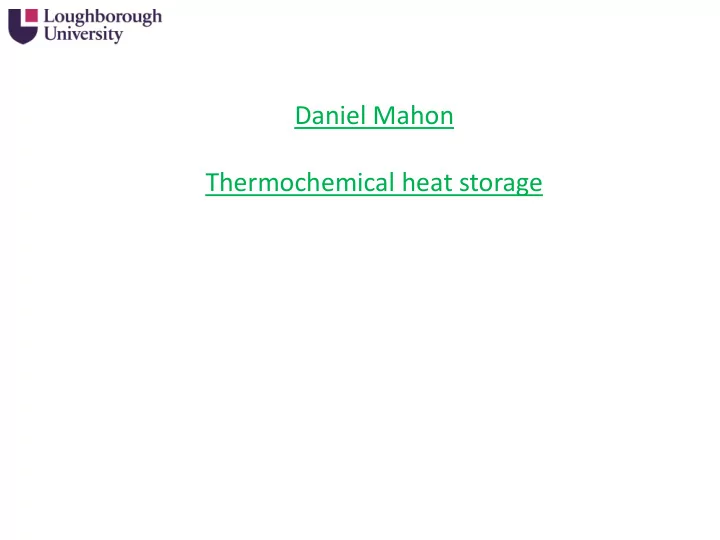

Daniel Mahon Thermochemical heat storage
MgSO 4 .7H 2 O Potential of MgSO 4 .7H 2 O High energy density – 2.8GJ/m 3 ( 778kWh/m 3 ) [1] Relatively cheap - ~ £61/1000kg [2] Sensible heat losses only 10% heat loss [1] Stores heat indefinitely Non-Toxic or Corrosive Problems with MgSO 4 .7H 2 O Cycle stability Vapour transportation / Slow hydration Rehydration conditions
MgSO 4 SEM + EDX Before any dehydration “large particles” After 1 ˚C/min dehydration After 10 ˚C/min dehydration 1 ˚C/min sample after rehydration (Average particle size = 2.4µm)
MgSO 4 Thermal analysis TGA TGA cycle stability results for 1 ˚C/min heating rate TGA cycle stability results for 10 ˚C/min heating rate
MgSO 4 Thermal analysis DSC DSC cycle stability data for MgSO 4 with a heating rate of 1 ˚C/min DSC cycle stability data for MgSO 4 with a heating rate of 10 ˚C/min
MgSO 4 Thermal analysis RGA RGA data for MgSO 4 different heating rates DSC & RGA Overlay showing unusual endothermic peaks
MgSO 4 Heat rate effects (Enthalpy) Heating Rate Max Enthalpy Average Peak ( ℃ /min) Data for various Temperature (normalized) Enthalpy Temperature (℃) (℃) heating rates and (J/g) (J/g) maximum 1 110 1230.6 87.045 dehydration 5 110 1330.1 1284 100.389 temperature 10 110 1291.5 101.764 1 150 1429.4 87.323 5 150 1382.1 1386 100.190 10 150 1347.3 114.412 Heating Rate ( ℃ /min) 1 5 10 Enthalpy (normalized) (J/g) (cycle 1) 1429.4 1382.1 1347.3 Data showing Enthalpy (normalized) (J/g) (cycle 2) 1268.1 1284.4 1340.3 dehydration cycle stability with Enthalpy (normalized) (J/g) (cycle 3) 1315.8 1244.9 1094.2 different heating Enthalpy (normalized) (J/g) (cycle 4) 1303.7 1053.5 1275.8 rates Enthalpy (normalized) (J/g) (cycle 5) 1279.6 1216.4 1218.0 Enthalpy (normalized) (J/g) (cycle 6) 1413.3 1564.3 1446.3 Enthalpy (normalized) (J/g )(cycle 7) 1296.3 1217.9 1208.2
Zeolite Cycle stability (Zeolite-Y ammonium SiO 2 .Al 2 O 3 925 m 2 g) Cycle stability of Zeolite 752J/g = Average dehydration enthalpy Heating rates minimal effect on material Lack of “slow kinetics”
Composite analysis (Zeolite + MgSO 4 ) • Creation of composite materials with different wt% – for increased vapour transportation – Decreased hydration time – Higher peak temperature output
Composite analysis (Zeolite + MgSO 4 ) Dehydration Enthalpy of composite Samples 1200 Dehydration data 1000 for several Zeolite + MgSO 4 800 Run 1 composites 600 Run 2 Predicted 400 No sign of pore 200 blocking 0 15 wt% 20 wt% 25 wt% 30 wt% 35 wt% Sample Run Wt% Predicted Experimental Average % difference Peak Temp ( ˚ C) No. No. Enthalpy Enthalpy J/g Enthalpy Experimental/Predict J/g J/g ed 1 1 35 943.8 1126.2 1126.2 19.3% 76.19 2 1 30 1026.2 72.58 3 1 30 916.4 1067.1 1046.65 14.2% 73.40 4 1 25 960.99 88.70 5 1 25 889.00 988.64 974.81 9.65% 89.18 6 1 20 918.88 86.17 7 1 20 861.60 905.16 912.02 5.86% 87.40 8 1 15 826.86 85.02 9 1 15 834.20 862.52 844.69 1.26% 85.20
Conclusion • MgSO 4 – Good cycle stability – Little effect from high heating rates – Potential to use lower dehydration temperature • Zeolite (Y ammonium SiO 2 .Al 2 O 3 925 m 2 g) – Lack of slow kinetics – Relatively large heat storage potential – Good cycle stability • Composite materials – Higher than expected enthalpy – No degradation from pore blocking observed
Industrial Absorbent Analysis Minimal mass loss below 150 ˚C (approx. 7%) • Low endothermic peaks • Low storage potential (approx. 180J/g)
Composite analysis – Industrial Absorbent SEM coloured images key Layered porous structure Colour Purple Yellow Green Calcium Magnesium Oxygen (Ca) (Mg) (O) These cube structures may be dolomite CaMg(CO 3 ) 2
Recommend
More recommend